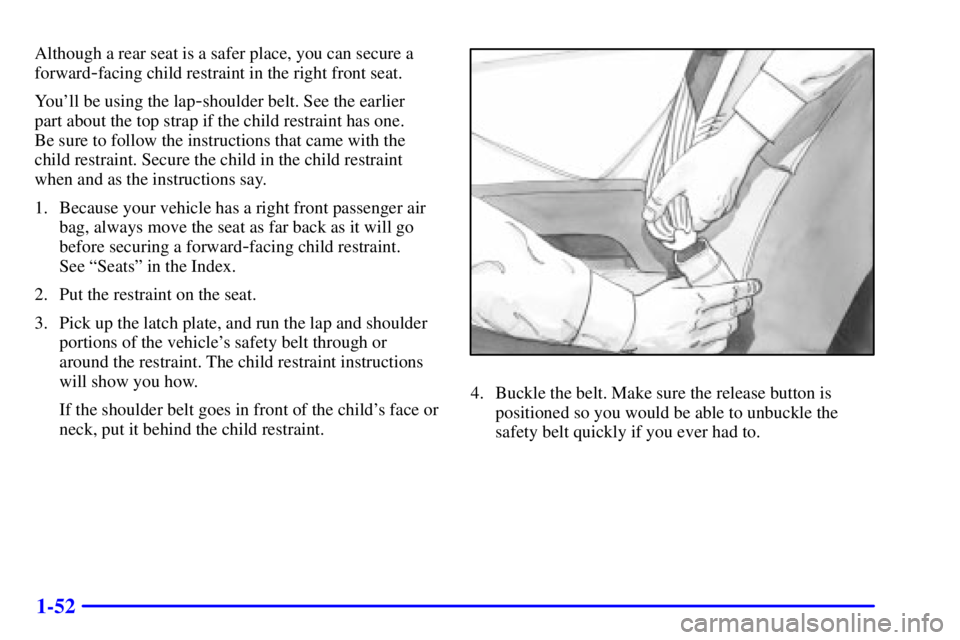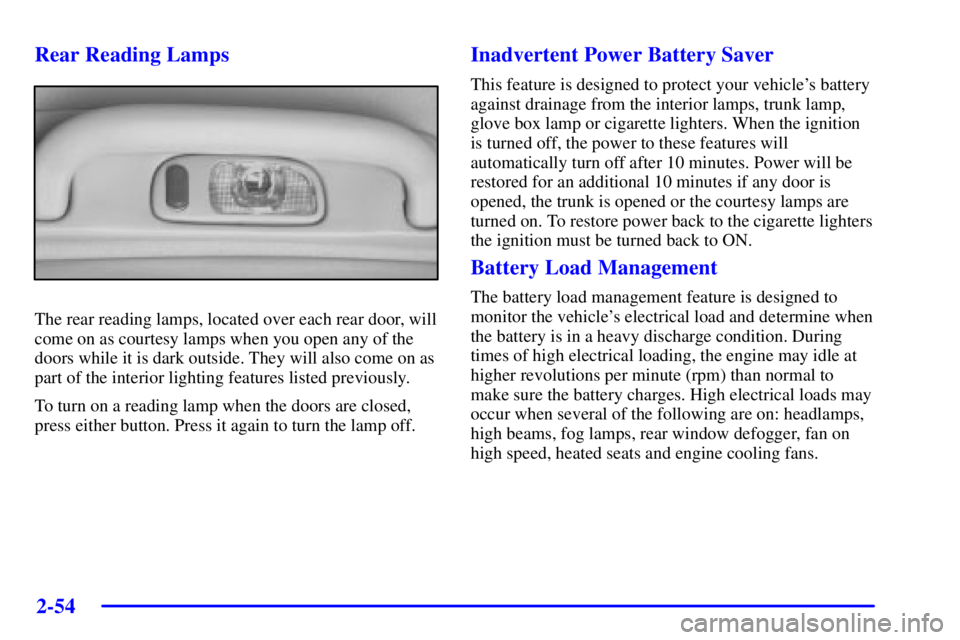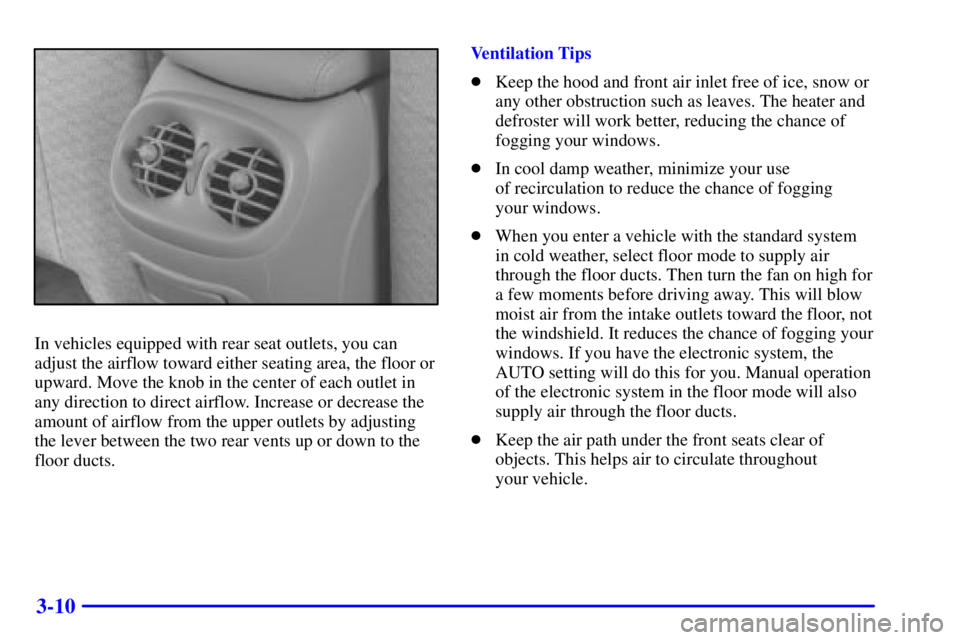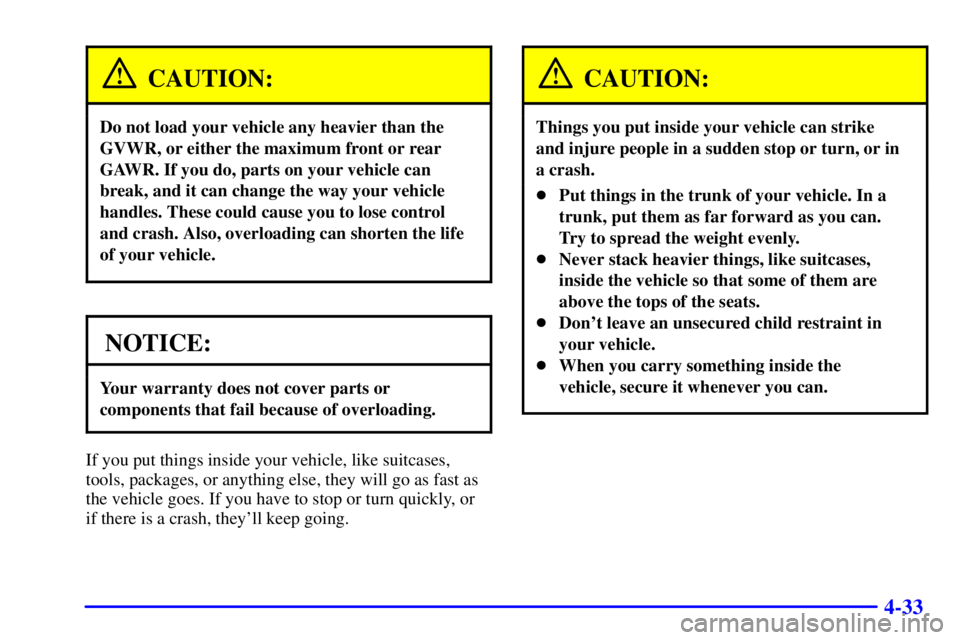Page 58 of 427

1-52
Although a rear seat is a safer place, you can secure a
forward
-facing child restraint in the right front seat.
You'll be using the lap
-shoulder belt. See the earlier
part about the top strap if the child restraint has one.
Be sure to follow the instructions that came with the
child restraint. Secure the child in the child restraint
when and as the instructions say.
1. Because your vehicle has a right front passenger air
bag, always move the seat as far back as it will go
before securing a forward
-facing child restraint.
See ªSeatsº in the Index.
2. Put the restraint on the seat.
3. Pick up the latch plate, and run the lap and shoulder
portions of the vehicle's safety belt through or
around the restraint. The child restraint instructions
will show you how.
If the shoulder belt goes in front of the child's face or
neck, put it behind the child restraint.
4. Buckle the belt. Make sure the release button is
positioned so you would be able to unbuckle the
safety belt quickly if you ever had to.
Page 60 of 427
1-54
Older Children
Older children who have outgrown booster seats should
wear the vehicle's safety belts.
Q:What is the proper way to wear safety belts?
A:If possible, an older child should wear a
lap
-shoulder belt and get the additional restraint a
shoulder belt can provide. The shoulder belt should
not cross the face or neck. The lap belt should fit
snugly below the hips, just touching the top of the
thighs. It should never be worn over the abdomen,
which could cause severe or even fatal internal
injuries in a crash.
Accident statistics show that children are safer if they
are restrained in the rear seat.
In a crash, children who are not buckled up can
strike other people who are buckled up, or can be
thrown out of the vehicle. Older children need to
use safety belts properly.
Page 93 of 427
2-30
Automatic Transaxle Operation
Your automatic transaxle may have a shift lever
located on the console between the seats or on the
steering column.
There are several
different positions for
your shift lever.
PARK (P): This position locks your front wheels. It's
the best position to use when you start your engine
because your vehicle can't move easily.
CAUTION:
It is dangerous to get out of your vehicle if the
shift lever is not fully in PARK (P) with the
parking brake firmly set. Your vehicle can roll.
Don't leave your vehicle when the engine is
running unless you have to. If you have left the
engine running, the vehicle can move suddenly.
You or others could be injured. To be sure your
vehicle won't move, even when you're on fairly
level ground, always set your parking brake and
move the shift lever to PARK (P).
See ªShifting Into PARK (P)º in the Index.
If you're pulling a trailer, see ªTowing a Trailerº
in the Index.
Page 117 of 427

2-54
Rear Reading Lamps
The rear reading lamps, located over each rear door, will
come on as courtesy lamps when you open any of the
doors while it is dark outside. They will also come on as
part of the interior lighting features listed previously.
To turn on a reading lamp when the doors are closed,
press either button. Press it again to turn the lamp off.
Inadvertent Power Battery Saver
This feature is designed to protect your vehicle's battery
against drainage from the interior lamps, trunk lamp,
glove box lamp or cigarette lighters. When the ignition
is turned off, the power to these features will
automatically turn off after 10 minutes. Power will be
restored for an additional 10 minutes if any door is
opened, the trunk is opened or the courtesy lamps are
turned on. To restore power back to the cigarette lighters
the ignition must be turned back to ON.
Battery Load Management
The battery load management feature is designed to
monitor the vehicle's electrical load and determine when
the battery is in a heavy discharge condition. During
times of high electrical loading, the engine may idle at
higher revolutions per minute (rpm) than normal to
make sure the battery charges. High electrical loads may
occur when several of the following are on: headlamps,
high beams, fog lamps, rear window defogger, fan on
high speed, heated seats and engine cooling fans.
Page 118 of 427

2-55
If your vehicle's battery remains in a heavy discharge
condition for a long period of time, the fan, rear
defogger, heated seats and heated mirrors will be
disabled and the DIC will display BATTERY SAVER
ACTIVE. This can happen either under long periods of
idling or low speed driving with high electrical loading,
or in the event of a charging system fault.
Monitor the battery voltage when in the BATTERY
SAVER ACTIVE mode.
�If the voltmeter remains in the shaded area
(below 11 volts) when driving then have the
charging system serviced immediately.
�If the voltage increases above 12 volts then the
battery needs to be recharged. Try driving on
the highway with as few electrical accessories on
as possible.
Mirrors
Inside Day/Night Manual Rearview Mirror
When you are sitting in a comfortable driving position,
adjust the mirror so you can see clearly behind your
vehicle. Grip the mirror in the center to move it up or
down and side to side. The day/night adjustment allows
you to adjust the mirror to avoid glare from any
headlamps behind you. Push the tab away from you for
daytime use; pull it toward you for night use.
Electrochromic Day/Night Rearview Mirror
(If Equipped)
Your vehicle may have an automatic electrochromic
day/night rearview mirror. Your vehicle's mirror may
also contain OnStar
� controls.
(On/Off): This is the on/off button for mirrors
equipped with OnStar controls.
When this feature is turned on, the mirror automatically
changes to reduce glare from headlamps behind you. A
photocell on the mirror senses when it is becoming dark
outside. Another photocell built into the mirror face
senses when headlamps are behind you.
At night, when the glare is too high, the mirror will
gradually darken to reduce glare (this change may take a
few seconds). The mirror will return to its clear daytime
state when the glare is reduced.
Mirror Operation
To turn on the automatic dimming feature, press AUTO
(or the on/off button for mirrors equipped with OnStar
controls). To turn off automatic dimming, press OFF
(or the on/off button for mirrors equipped with OnStar
controls). The indicator light will be illuminated when
this feature is active.
Page 166 of 427

2-103 DIC Personalization Programming
The DIC can be used to program the following
personalization features available with your vehicle:
�Automatic Door Locks
�Window Lockout
�Security Feedback
�Delayed Locking
�Perimeter Lighting
�Memory Seats
�Parallel Park Assist Mirror (Tilt Mirror)
�Driver ID
The DIC is used to program the personal choices of two
drivers. The drivers are recognized as DRIVER #1 and
DRIVER #2. You will let the DIC know which driver
you are by using your remote keyless entry transmitter
or by pressing the appropriate memory seat control
button located on the driver's door or by choosing the
driver with the DIC. Each remote keyless entry
transmitter was preprogrammed to belong to DRIVER
#1 or DRIVER #2. Each transmitter may be
programmed differently for each driver.When you press the button with the unlock symbol on
your transmitter, the DIC will automatically change
driver numbers and the vehicle will recall the
personalization settings that were last made to
correspond to your transmitter, including your radio and
comfort control settings. See ªComfort Controls
Personalizationº in the Index.
If you unlock the vehicle using your door key instead of
your transmitter, the DIC will not change drivers and
will recall the information from the last transmitter use
or the last driver change using the memory seat controls.
If this happens and you were not the last driver of the
vehicle, simply press your correct driver number on
the memory seat controls or press the button with the
unlock symbol on your transmitter or select the
personalization programming mode and choose the
correct driver number.
Use the following steps for personalization
programming instructions.
1. Turn the ignition on and keep the transaxle
in PARK (P).
2. Press the MODE button to reach personalization
programming display.
Page 184 of 427

3-10
In vehicles equipped with rear seat outlets, you can
adjust the airflow toward either seating area, the floor or
upward. Move the knob in the center of each outlet in
any direction to direct airflow. Increase or decrease the
amount of airflow from the upper outlets by adjusting
the lever between the two rear vents up or down to the
floor ducts.Ventilation Tips
�Keep the hood and front air inlet free of ice, snow or
any other obstruction such as leaves. The heater and
defroster will work better, reducing the chance of
fogging your windows.
�In cool damp weather, minimize your use
of recirculation to reduce the chance of fogging
your windows.
�When you enter a vehicle with the standard system
in cold weather, select floor mode to supply air
through the floor ducts. Then turn the fan on high for
a few moments before driving away. This will blow
moist air from the intake outlets toward the floor, not
the windshield. It reduces the chance of fogging your
windows. If you have the electronic system, the
AUTO setting will do this for you. Manual operation
of the electronic system in the floor mode will also
supply air through the floor ducts.
�Keep the air path under the front seats clear of
objects. This helps air to circulate throughout
your vehicle.
Page 255 of 427

4-33
CAUTION:
Do not load your vehicle any heavier than the
GVWR, or either the maximum front or rear
GAWR. If you do, parts on your vehicle can
break, and it can change the way your vehicle
handles. These could cause you to lose control
and crash. Also, overloading can shorten the life
of your vehicle.
NOTICE:
Your warranty does not cover parts or
components that fail because of overloading.
If you put things inside your vehicle, like suitcases,
tools, packages, or anything else, they will go as fast as
the vehicle goes. If you have to stop or turn quickly, or
if there is a crash, they'll keep going.
CAUTION:
Things you put inside your vehicle can strike
and injure people in a sudden stop or turn, or in
a crash.
�Put things in the trunk of your vehicle. In a
trunk, put them as far forward as you can.
Try to spread the weight evenly.
�Never stack heavier things, like suitcases,
inside the vehicle so that some of them are
above the tops of the seats.
�Don't leave an unsecured child restraint in
your vehicle.
�When you carry something inside the
vehicle, secure it whenever you can.